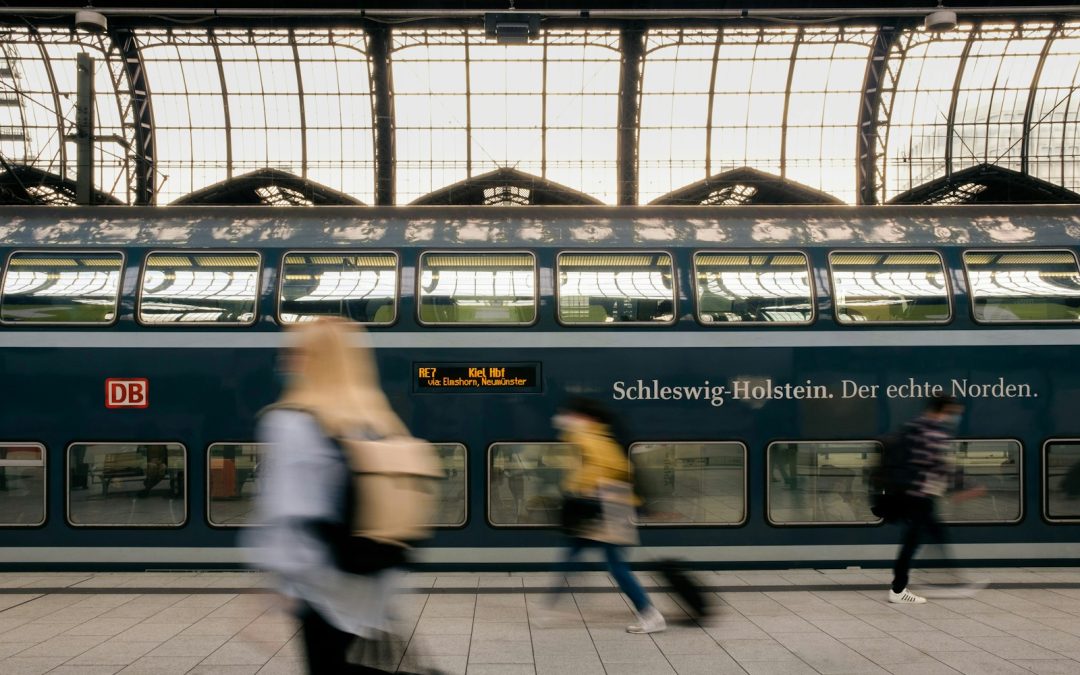How can we build on the progress made so far to make rail travel truly accessible, affordable and reliable for...
Most modern trains are primarily made of metals like steel and aluminium, which are long-proven materials designed to ensure the comfort and safety of these vehicles. However, composite materials – first tried and tested in the aeronautical sector – are being used with increasing success in railway rolling stock to replace or complement metal materials.
Composite materials, used alone or in combination with metallic materials, offer significant weight savings. Typically 20% or more when employed in train carriages and as high as 60-70% when incorporated into running gear, i.e. all the components of a railway vehicle that run passively on the rails. Cost-efficient and reliable long-lasting trains will play a huge role in fostering the modal shift towards rail and boosting the success of the European rail system.
Under the Europe’s Rail Joint Undertaking, a series of seven technical demonstrators (TDs) have emphatically highlighted how cutting edge composite or other lightweight materials, plus new technologies, can deliver both significantly lighter trains and running gear. This will notably result in 1) lighter, more energy-efficient passenger trains that are more comfortable for passengers and have a lower impact on the track, thus reducing the life cycle cost of the entire railway system; and 2) more efficient rolling stock, thanks to extended overhaul periods and improved maintenance processes.
Light Structures
A train carriage is for transporting passengers and serves as the physical link for all elements in the vehicle. Current carriage structures, constructed mainly from steel or aluminium, have nearly exhausted their potential for weight reduction. So innovative approaches to create lighter structures are needed, in order to unlock further energy savings and associated advantages. One way to achieve this is through pioneering designs for carriage shells, so as to leverage the full potential of composite materials. This work includes integrating functions to facilitate enhanced energy efficiency or increased payload capacity.
Here, the Light Structures TDs developed and demonstrated a new generation of carriage shells, calling on composite or other lightweight materials:
Solution: Talgo full carbody demonstrator
- What: Demonstration of hybrid carriage in which the end walls are made of aluminium whereas the roof, lateral panels, and floor/main frame are made of composite materials.
- Work: Design, prototyping, testing and validation of innovative composite materials.
- Result: A complete carriage shell was developed, to replace the current aluminium carriage of an intermediate coach of TALGO 350 HST train.
- Who benefits: Real-world rail operators.
Solution: Siemens Mobility carbody end demonstrator
- What: Demonstration of full-scale hybrid carriage end, based on the existing design of an intermediate coach (Siemens Mobility High-Speed Train platform VELARO).
- Work: Design, prototyping, testing and validation of innovative composite materials.
- Result: Two carriage end modules were developed, to replace both complete end sections of the carriage.
- Who benefits: Real-world rail operators.
Solution: Alstom underframe headstock demonstrator
- What: Demonstration of full-scale hybrid end structure of the underframe area (‘headstock’) of a Metro train’s end carriage or intermediate carriage.
- Work: Design, prototyping, testing, and validation of innovative composite materials.
- Result: This demonstrator is intended to replace the existing headstock of the underframe in a C30 Metro carriage, currently made of aluminium.
- Who benefits: Real-world rail operators of Metro trains.
Main results
- Overall achievement of weight reduction targets, c. 20% less weight achieved.
- Manufactured several demonstrators, including all necessary tools.
- Fewer components, thanks to streamlined integration process with composite parts.
- Successful completion of tests in line with EN 12663-1 (minimum structural requirements for railway vehicle bodies) and other applicable standards.
- Simulation methods and criteria aligned with testing outcomes.
- Meaningful collaboration between the railway and aeronautics sectors.
- Addressed various materials, manufacturing methods, and segments throughout development.
- Composite carriage shells are validated at TRL levels, from TRL4 (basic technological components) to TRL6 (prototype system).
Conclusions
The consortium – comprising rolling stock manufacturers, an aeronautics company, research centres, and an operator – successfully produced several full-scale demonstrators. These employed a hybrid carriage concept that integrates composites and metallic parts. This approach met the targeted weight reduction objectives and demonstrated compliance with current railway standards.
Testing of the three demonstrators confirmed that composite materials are a viable alternative for structural railway applications, enabling a weight reduction of around 20% for carriage applications.
This experience has also resulted in a new CEN Working Group, tasked with defining a standardised process to facilitate the integration of new materials into railway applications. Once released, this standard will apply to all rolling stock and its onboard equipment, streamlining the adoption of new materials across the railway industry. This is important, due to the lack of standardisation on composite materials for such uses.
Light running gear
Bogie systems are key for a train’s safety, reliability, comfort, and performance. But conventional systems can only achieve higher performance and reduce wear if compromises are made to safety and comfort. The challenge now is to develop new bogie solutions, so as to deliver reduced wear and damage to both infrastructure and wheels, while increasing reliability and availability, and lowering maintenance costs.
Overall, the Light running gear TDs developed and demonstrated a new generation of running gears, calling on composite and new elastomeric formulations:
Solution: Lighter bogie component demonstrators
- What: Demonstrations included a primary spring and an antenna beam made of composite materials that were developed by Alstom.
- Work: Design, manufacturing, testing and validation of composite primary springs for bogies and of composite antenna beams.
- Results: By replacing traditional metal springs with composite primary springs in the primary suspension, the bogie’s weight was considerably reduced. A similar effect was achieved by replacing the conventional welded construction of an antenna beam, made of structural steel, by its counterpart in composite materials.
- Who benefits: Real-world rail operators.
Solution: Single axle running gear frame demonstrator for metro
- What: Demonstration of composite materials, implemented by Trafikverket.
- Work: Design, prototyping, testing and validation of composite running gear frame for lightweight metro vehicles, using Carbon Fibre Reinforced Plastic (CFRP) and metallic inserts.
- Result: By reducing the number of axles in the running gear, a significant reduction in weight and complexity (fewer number of parts) was achieved.
- Who benefits: Real-world rail operators.
Solution: Single axle independent rotating wheel running gear demonstrator
- What: Demonstration for high-speed applications made of composite materials, implemented by Talgo.
- Work: Design, prototyping, testing and validation of lightweight single axle independent rotating wheel running gear frame, constructed with a combination of composite materials and high-strength steel alloy.
- Result: Developed a complete single axle independent rotating wheel (IRW) running gear frame made of composite materials and high-strength steel alloys. Running gear frame assembly weight reduced by 50%.
- Who benefits: Real-world rail operators.
Solution: Innovative elastomer-based running gear component demonstrators
- What: Demonstrations included new elastomer-based components for running gear, e.g. the conical spring and the bush of the swingarm.
- Work: Design, prototyping, and testing of novel elastomer-based components for running gear, including use of new and stronger adhesives between elastomeric and metallic parts.
- Results: Evaluated the feasibility of using innovative elastomer solutions of improved performance and increased lifetime, to extend the maintenance intervals for these critical components. Could dramatically extend overall running gear maintenance intervals, and significantly reduce associated life cycle costs of the running gear.
- Who benefits: Real-world rail operators.
Main results
- Use of composite materials technologies in primary springs and other structural components of the running gear, including the running gear frame, has notably progressed. Solutions at Technology Readiness Levels (TRL) from TRL4 to TRL6.
- Overall achievement of the weight reduction initial targets, ranging from 60-70% in the lighter bogie component demonstrators and 46% less weight in the Talgo’s single-axle independent rotating wheel running gear demonstrator to the 20% potential for the single axle running gear frame demonstrator for metro.
- Several full-scale demonstrators were successfully manufactured, including all necessary tools.
- Successful completion of validation tests at laboratory level, in accordance with EN 12663-1 and other applicable standards.
- Innovative elastomer formulations using nanoengineered materials confirmed the potential of this technology to improve the performance/durability of the elastomeric components in running gears.
Conclusions
The testing of these four demonstrators confirmed that composite materials are a viable alternative for structural railway applications in running gears. It also underlined that new elastomeric formulations, incorporating nanoengineered additives, could enhance the performance and durability of elastomeric materials for running gear applications.
Through a significant reduction in weight, increased durability, and reduced maintenance requirements, these innovations can dramatically improve the overall efficiency of the railway system including both rolling stock and the infrastructure. The results obtained pave the way for reduced energy consumption, increased payload capacity and lower maintenance costs of the overall railway system. Despite advancements in composite materials, challenges such as fatigue failure may still arise. This highlights the need for further research and development work for their use in train carriages and running gear.

















